![]()
|
Dyno Runs
Stock 200SX SE-R
Mike Kojima's 200SX SE-R (SCC Project SE-R)
Project SE-R with the engine modifications broken down
Project SE-R with the addition of Unorthodox Racing pulleys
Project SE-R with JWT's 100hp NOS
Project SE-R vs DPR Integra GSR
Zak Nilson's Turbo NX2000
Jay Stewart's NX2000
Ryan
Besterwitch's FMAX Turbo 200SX 392hp @ the Wheels!
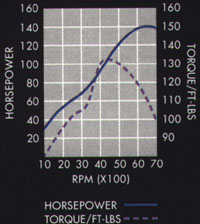 Here's a picture we found that
shows the 200SX SE-R's Stock power band. This picture is, of course, not on a
Dynometer, but we thought you might like:
Here's a picture we found that
shows the 200SX SE-R's Stock power band. This picture is, of course, not on a
Dynometer, but we thought you might like:
Mike was kind enough to provide his charts in Excel format.
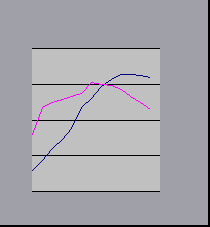 Here's a Dyno chart of Mike Kojima's 200SX SE-R
Here's a Dyno chart of Mike Kojima's 200SX SE-R
(The engine made 164.1 hp@ 6300 rpm and 151.8 ft/lb of torque@ 4500 rpm at the wheels on DRR's Dynojet chassis dyno. This equates to almost 190 crank hp.)
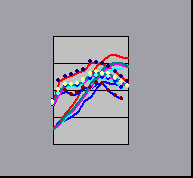 Here's the same engine but with the modifications
broken down.
Here's the same engine but with the modifications
broken down.
Mike writes:
Present HP 11:1 cr
Engine has all the bolt-on mods, A small port DPR stage 6 head and Place Racing CAI. For this step, the
following additional parts were added: JWT prototype 2045cc 87mm big bore pistons with a
flat top for 11.2:1compression ratio with the cloverleaf combustion chamber DPR stage 6
head. The pistons are coated with SwainTech's Poly Moly dry film lubricant on the
skirts and Gold Coat Heavy duty thermal barrier coating on the domes. All
reciprocating parts are balanced to within 1/2 gram. SR20DET piston coolers have been
added. The block has been bored and honed with a torque plate with a final low
friction platue hone by JWT. The block has been decked 0.010" for 0.035 quench
clearance. The exhaust valves have been more radically contoured on the DPR
head. This is the configuration that DPR customers will get. The head has been
surfaced by 0.030" during the process so JWT cam timing gears are used to
restore the standard cam timing which was found to work best in earlier testing. The
total of 0.040 total surfacing (0.010" block+0.030" head) will retard the cam
timing by about 3-4 degrees so we advanced both cams by 2.5 degrees to correct the
timing. The slight retard should help top end. JWT has reprogrammed the ECU
for the high compression and 92 octane pump gas. This setup gets 28 mpg so far and
190 crank hp! The OBD-II system works fine!
DPR stage 6 head + CAI
This stage entails all of the bolt ons, a DPR stage 6 head and the Place Racing
CAI (cold air intake). Note the nice power gain from just this little bolt on.
The CAI uses the JWT POP Charger as the filter. This would have up to 9 hp
over stock as it has about 7-8 hp over the POP alone (at some point in the power curve not
everywhere).
Bolt-ons+DPR stage 6 head
This adds a DPR stage 6 head to the common bolt on parts. The DPR head we
used is ported on the small side to keep velocity up for good torque and to keep the
OBD-II system from freaking out. It could be ported bigger for more peak hp but I
opted not to do it like that. The head has recontoured and lightened intake and
exhaust valves, full porting of both the intake and exhaust valves, a radiused valve job
done on a Serdi machine and a reconfigured cloverleaf shaped combustion chamber that
increases the CR to 10:1 and increases combustion turbulence for a better, faster burn.
The chamber volume is 43cc.
Bolt-ons
This is the point where most SE-R owners end up at. The following external
bolt on parts were added: Hotshot header, Greddy exhaust, JWT POP charger air filter, JWT
POP ECU, JWT street grind cams (the race cams made less power on a stock head and stock cr
motor), Nology wires, Nology power booster, JWT motor mounts, Clutch masters 11 lb
flywheel & stage 3 clutch and a Maxima MAF (mass airflow meter, this did not do
anything for power at this point). The JWT ECU raises the rev limit to 7700 rpm
which is a great help as the stock 7000 limit was lame and I was always hitting it. (I was
used to my classic's 7500 rpm limit). The JWT ECU also removes the lame 109 MPH
speed limiter. No more getting smoked by Civics on the freeway anymore! The
car is now fun to drive.
Stock
Well stock is uh... stock I guess. When I first got the car I was bummed
because my classic felt so much stronger. The measured speed difference was not that
much greater but it felt slower, less eager to rev. The lowered rev limiter and the
speed cut the Nissan installed on the 200SX was annoying.
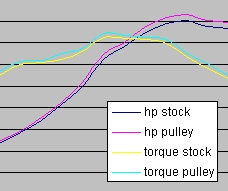 Here is a dyno chart of Mike Kojima's 200SX
SE-R with the addition of the Unorthodox Pulleys.
Here is a dyno chart of Mike Kojima's 200SX
SE-R with the addition of the Unorthodox Pulleys.
Yes, these things really work. Here it is
in Excel format.
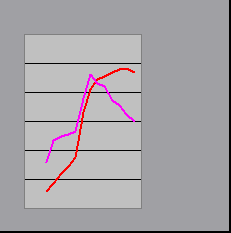 Here is the dyno chart of Project SE-R with JWT's
100hp NOS.
Here is the dyno chart of Project SE-R with JWT's
100hp NOS.
This is JWT's ECU controled automatic NOS system that uses only a single fan jet and solenoid. The JWT system uses a seperate independant daughterboard and E-Prom to control engine functions under NOS operation. When the system is enabled the ECU looks at CAS signal, TPS and MAF voltage. When WOT @ 4000 rpm is detected the ECU will automaticaly turn on the NOS solenoid and kick the injectors up to a higher duty cycle to provide inrichment. The ECU will also retard the spark. The factory rev limiter is maintaned by the ECU. This makes for a pretty safe system.
Due to it simplicity, it is also the easyest system to install. The stock injectors can be used for up to a 50 shot. For more than that, bigger injectors from a 94 or later turbo Z or Q45 must be used.
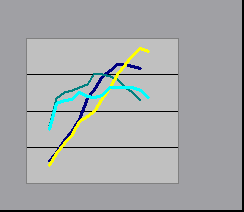 This
dyno chart shows a comparison of a fully built street Integra GSR
prepared by DPR verses project SE-R.
This
dyno chart shows a comparison of a fully built street Integra GSR
prepared by DPR verses project SE-R.
This is project SE-R in the latest 11:1 cr mode.
The GSR is equipped with:
The GSR makes a peak of 186 wheel hp! DPR's full race 13:1 All motor VTEC cars make as much as 225 wheel hp.
Things at first glance might seem bleak but fear not SE-R lovers, all is not lost. At a second glance note that the SE-R makes much more torque and produces lots more hp (as much as 30 more) at lower rpms. In fact the GS-R does not pass the SE-R until it is almost time to shift. So the GSR 's power peak will not come into play until the higher gears were the dwell time in this narrow rpm ban is greater.
Also note that the GSR's power peaks and falls off quickly while the SE-R's peak power stays constant. This means the SE-R will pull hard all the way through a gear.
The SE-R has more power under the curve with a broad, tractable power band. The high strung GSR makes it power in a narrow, high power peak which means you will have to beat the hell out of it to make it go. Guess which car will be more fun to drive on the street!
The GSR also weighs about 250-300 lbs more than the SE-R which about evens the odds. So the SE-R should be able to pull the GSR initially with the GSR charging hard at the lights. It should be pretty close. Finally this is a professionally built GSR with all the best parts, workmanship and dyno tuning. You are not likely to line up with one of these in your typical street encounter. Dan Paramore told me that a typical stock GSR makes around 140-142 hp at the wheels.
I think this means that a well built SE-R has nothing to fear unless you spot a front mount intercooler and/or a DRAG windshield border sticker.
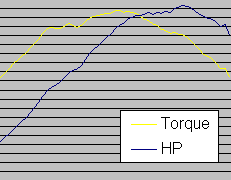 Here is a dyno chart of Zak Nilsson's SR20DET powered NX2000.
Here is a dyno chart of Zak Nilsson's SR20DET powered NX2000.
Here it is in Excel Format.